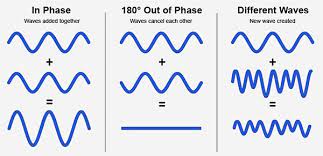What are Binaural Beats?
This blog is an addendum to the Drug and Alcohol Review journal article available in the “Academic” section of my website.
First, have a listen. You need to wear headphones for the effect to work:
What you’re listening to is a Binaural Beat of 2 Hz. To explain how we got there, I need to discuss what sound is and how we perceive it. Sound is vibrating air particles in the atmosphere around us. The air moves in waves that compress and expand very quickly. This is measured in frequency (cycles per second) notated in Hertz (Hz). Sine waves, that I used here are the perfect representation of this phenomenon.
Binaural Beats also work on a psychoacoustic level that disorients how we localise sound. Firstly, nowhere in nature do we hear sound exclusively in one ear. For example, if we are on an African savannah and we hear a lion roar our brains localise that sound due to subtle differences in volume (it will be louder in the closer ear), timing (it will arrive at the nearer ear first), and tone (the sound is slightly filtered by the shape of our heads, the shape of our ears, and by the amount of direct and reflected sound it receives). As we are always in space for sound to propagate, in nature both our ears are used to perceiving sound at the same time. Assuming the roaring lion is not directly in front of us (we wouldn’t be around to tell this story), the sound reaching each ear will be different and that helps us localise the sound (and hopefully we won’t get eaten).
In the Binaural Beat above, the volume presented to each ear is equal and the tone is very similar. So it is the timing aspect and the phase relationship between the waveforms that confuses the brain. In the roaring lion example, due to the space between our ears, the waveform of sound that reaches the closest ear will be different to the ear that is furthest away. This creates a phase difference in how each ear perceives the sound and is a large part of sound localisation and this is why our hearing is known as Binaural.
The final part I need to discuss is phase relationships in sound. If we look at a simple waveform and we add the same waveform to it, the waveform will double in size (be twice as loud). If the waveforms are 180 degrees out of phase and we add them together we will get no sound. However, if we present these two out-of-phase signals separately to each ear, they do not cancel out. Our brain appears to place the signals outside of the normal stereo field—beyond the speakers (or headphones). See the below image:

image: https://ledgernote.com/columns/mixing-mastering/phase-cancellation/
Now, this brings us to the Binaural Beat I created above. A “Binaural Beat” is produced by presenting a tone of 440 Hz in the left ear and a tone of 442 Hz in the right ear. The frequencies are very close together so they quickly modulate between being in and out of phase with each other. The moment that they are in phase is known as the Binaural Beat—2 Hz (the difference between the frequencies) in this example. I’ve made a version of the same sound only in mono to hear the “beat” clearer:
This is the part that the brain can understand and is said to entrain brain waves. The research on this is very sceptical, and here I am only attempting to explain how the phenomena works, not if it works. Additionally, the research has described it as an illusory tone, or a third tone. I don’t agree with these descriptions and have described it as a modulating dyad. A Dyad is the music theory term for a two-note chord. Modulation refers to the frequency of the “beat”. Technically, I should be described as an out-of-phase modulating dyad. Furthermore, the research conducted in this space uses pure sine waves, like the examples here. The Binaural Beats the participants listened to in the DAR article used Youtube and other streaming patterns. As far as I know, complex music has not been investigated empirically.
I hope this helps.
